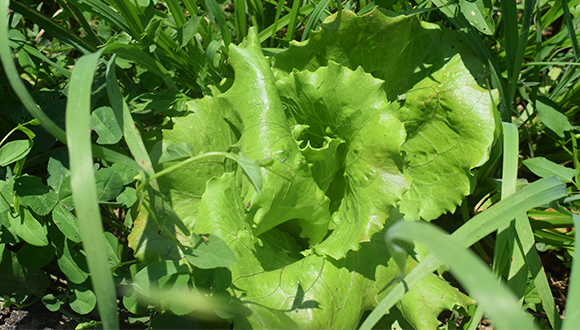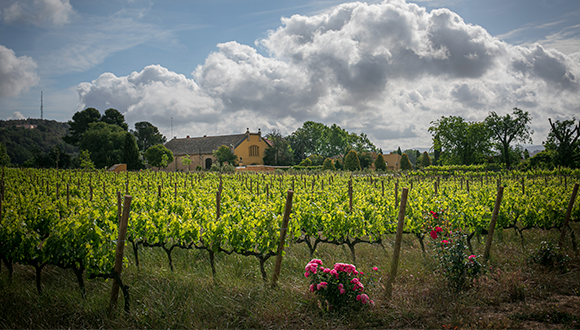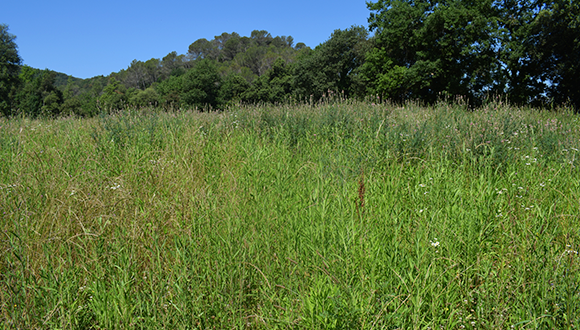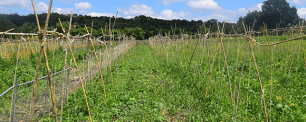What is regenerative agriculture?
You go to a supermarket and you find what you want regardless of whether it is its growing season or not: plums, mangoes and melons in January. How is this possible? This is possible because our agri-food system backbone is based on overproducing food.
But this implies a tremendous environmental cost: overgrazing, intensive agriculture and deforestation, for example, three human activities responsible for soil deterioration and the current climate crisis. In this context, the regenerative model emerges as an effective way to reverse the situation. Why is it so revolutionary? Is it different from the organic model? Is there a certification? What organisations and projects are working on it?
Regenerative agriculture claims that soil health is intrinsically linked to the overall sustainability of our food system, including both our health and the Planet's health. Therefore, it aims to regenerate, stimulate and maintain soil fertility and biodiversity: it enhances a soil with high content of organic matter, biodiversity and the ability to produce food using nature's own resources.
It does this by employing agricultural, livestock and silvicultural techniques that naturally nourish plants and protect soil from interventions that may affect its own biological processes. Warning! It doesn't mean going back to the past. On the contrary, it is an innovative model that incorporates all the new scientific knowledge we have today about how soil and vegetation nutrition works.
Warning! It doesn't mean going back to the past. On the contrary, it is an innovative model that incorporates all the new scientific knowledge we have today about how soil and vegetation nutrition works.
Based on this, the practices it proposes are characterised by eliminating tillage, which breaks down soil structure; maintaining vegetation cover, in order to avoid leaving the land bare and prevent soil erosion; increasing plant diversity and production; combining agriculture and livestock farming, using grazing animals to fertilise the ground, while the animals enjoy a good diet; planning a better use of water; and avoiding the use of heavy machinery, fertilisers, pesticides and chemical fertilisers so as not to deteriorate the soil, nor to depend on large agrochemical companies.

A step beyond organic
The term 'regenerative agriculture' was first defined in the early 1980s by the Rodale Institute. This US non-profit organisation described it as a real alternative to conventional agriculture, which damages the land, the planet's health and our own, and as a step beyond organic. But why? Ecological or organic agriculture proposes practices that focus on maintaining the conditions of the soil ecosystem, not damaging it, preserving its biodiversity and reducing pollution. But regenerative agriculture goes a 'step further' and not only maintains but also enhances the recovery of degraded soils: it exponentially increases their organic matter content, their capacity to retain and use water, and the diversity of plants, insects and microorganisms that form part of their food web.
Adapting to climate change
Regenerative agriculture is becoming increasingly important as part of the solution to the current climate crisis. Why? On the one hand, as organic matter content increases, the soil's capacity to store water increases. This softens the effect of flooding and erosion from heavy rainfall and helps crops be productive under severe arid climatic conditions, such as the increasingly frequent droughts.
Fertile land also absorbs much more atmospheric CO2 and can store it in the form of atmospheric carbon in the soil, reducing its concentration in the atmosphere.
Fertile land also absorbs much more atmospheric CO2 and can store it in the form of atmospheric carbon in the soil, reducing its concentration in the atmosphere. They are also practices that produce far fewer greenhouse gas emissions, as they use almost no heavy machinery or fertilisers and do not burn fossil fuels.

In addition, it also promotes social benefits in the fight against rural abandonment, as it is committed to any farmer being able to replicate it on their farm without a significant economic investment, and in the promotion of food sovereignty, because a country with fertile land that does not depend on large companies is capable of producing quality food and making decisions about its own agricultural and food policies.
Diverse practices
The regenerative model integrates and combines several sustainable agricultural and livestock practices. Some of them are
- Natural farming- it intervenes as little as possible in the soil so that natural processes can do their work, the soil is not tilled, weeds are not removed, nor are herbicides, pesticides or chemical fertilisers used. It also proposes crop rotation within the same year.
- Organic agriculture- does not damage the soil, as it does not use chemical products, produces biofertilisers and uses native microorganisms to nourish the soil.
- Carbon farming- involves leaving the soil unploughed to sequester atmospheric carbon, as ploughing fields can alter the soil's natural structure and release the carbon stored in the ground into the atmosphere.
- Pasture cropping- promotes the sowing of winter cereals directly onto perennial grasslands that are active in summer to increase annual pasture production.
- Agroforestry- it is a system that combines trees with crops or livestock on the same land to increase synergies between animals, which feed on fresh grass, and plants, which benefit from livestock excreta.
- Keyline design- is a technique that, according to the area's topography, designs the land to distribute water evenly.
- Holistic management- is a farming practice in which the animals are in continuous movement. Each day the cattle move to a new patch of pasture and take months to return to a pasture where they have already eaten so that the grass can recover from the impact and use cattle droppings to increase fertility.
- Rational Voisin grazing- is similar to holistic management; this is a husbandry practice of choosing the right time for cattle to graze on a given plot. It is based on knowledge of grass regrowth performance and animal needs and welfare.
- Polyface farms- are farms that integrate agriculture, forestry and grazing to increase soil fertility.
Is there a regenerative agriculture certification?
It is not yet established in Europe, but it is in the United States. In 2017, a group of farmers and ranchers, together with experts in soil science, animal welfare and social equity, promoted the regenerative organic certification in the USA. The three criteria for certifying a product as regenerative are soil health, animal welfare and social justice.

The 'soil health enhancement' criteria includes crop rotation, avoidance of agrochemicals, rotational grazing, reducing or eliminating soil tillage, and maintaining ground covers. In the case of animal welfare, they should be raised on pasture, not be injured or harmed, not experience distress and live in an adequate shelter. The working conditions include fair pay for producers and good working conditions for workers in terms of social equity.
Outstanding projects and organisations
One of the outstanding projects in Catalonia is Polyfarming, a project co-financed by the European Commission's LIFE programme and led by CREAF. It began in 2016 intending to recover the agricultural and livestock activity of an abandoned farm in Girona, Planeses, by using the regenerative model. After five years, the results confirm that this type of agriculture has great potential in the fight against climate change and rural abandonment.

For the project to transcend and be replicated on a national and international scale, Polyfarming has published the 'Polyfarming System Manual', an 'alphabet' of regenerative agriculture and livestock farming that aims to provide tools and knowledge so that anyone interested can learn about the model and apply it on their own farm.
For the project to transcend and be replicated on a national and international scale, Polyfarming has published the 'Polyfarming System Manual', an 'alphabet' of regenerative agriculture and livestock farming that aims to provide tools and knowledge so that anyone interested can learn about the model and apply it on their own farm.
Torres Family in Catalonia also implements regenerative agriculture in their vineyards. The aim is to achieve a new balance based on naturally increasing biodiversity and organic matter, thus enhancing the function of the vineyards as carbon sinks. Its agricultural plan contemplates converting to the regenerative model all their vineyards, distributed in the Penedès, Priorat, Conca de Barberà and Costers del Segre.
In the Altiplano of Granada, Los Vélez, Alto Almanzora, Guadix and Northwest of Murcia areas, AlVeAl is an association that works on the restoration of farms with degraded or eroded soils, using regenerative techniques in all these places.

Among the producers and organisations that sell regenerative products and disseminate this type of agriculture in Spain, stand out Regenerative Agriculture website, the Planeses farm, where the Polyfarming system is carried out, or Carne de Pasto.
On an international scale, the most cutting-edge organisations and projects are Regeneration International, Rodale Institute, Savory Institute and Kiss the Ground. Another of the most significant initiatives is the '4 by 1000'. It was launched at COP21 and prompted many governments to include soil carbon sequestration as part of the climate change strategies. The aim is to achieve an annual growth rate of 0.4% of carbon stocks in the top 30-40 cm of soil by 2050, thus significantly reducing the concentration of CO2 in the atmosphere. Another project that has recently started is AgriCaptureCO2, funded by the European Horizon2020 programme, which aims to promote regenerative agriculture through the use of new technologies.
The future will be regenerative, or it will not be
The transition to the regenerative model depends not only on producers but also on society that has to push for change. How? By buying regenerative products, supporting local policies of change, and pushing governments to support international initiatives that implement regenerative agriculture.
Start your own regenerative project!
According to the Polyfarming team, farmers starting a regenerative agriculture project should ask themselves five questions:

- Are we tapping the potential of plant diversity?
- How do I return the part of the production I take, for example, garden produce, back to the soil?
- How do I feed the soil food chain: insects, micro-organisms, animals, etc.? Are we disturbing the soil in any way, such as tilling or using chemicals, heavy machinery, etc.?
- What is the carbon cycle like on my farm?
- How do I manage water?
To go deeper into regenerative agriculture
Recommended readings and videos
- The One-Straw Revolution
- Kiss the Ground, Netflix.
- What is regenerative agricukture? - Interview with Marc Gràcia (with English subtitles)
- Polyfarming Manual
- Six essential techniques to discover regenerative agriculture!
- Growing a Revolution: Bringing Our Soil Back to Life
- The biggest little farm
- Arraigados en la tierra: Propuestas para una agricultura regenerativa
Bibliography:
- M. Gracia, M.J. Broncano, J. Retana (2021) Manual para el diseño e implementación de un modelo agroalimentario regenerativo: el sistema Polyfarming. Barcelona (España), CREAF.
- Web del Instituto Rodale.
- Fenster TLD, LaCanne CE, Pecenka JR et al. Defining and validating regenerative farm systems using a composite of ranked agricultural practices [version 1; peer review: 2 approved] F1000Research 2021, 10:115.
- Burgess PJ, Harris J, Graves AR, Deeks LK (2019) Regenerative Agriculture: Identifying the Impact; Enabling the Potential. Report for SYSTEMIQ. 17 May 2019. Bedfordshire, UK: Cranfield University.











